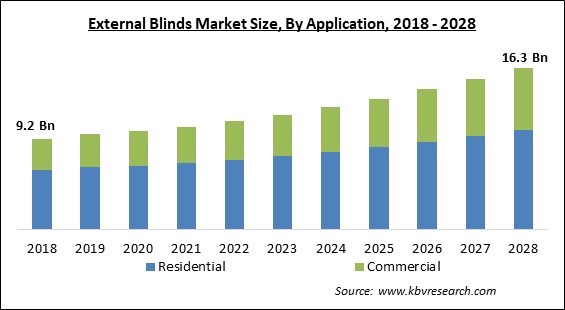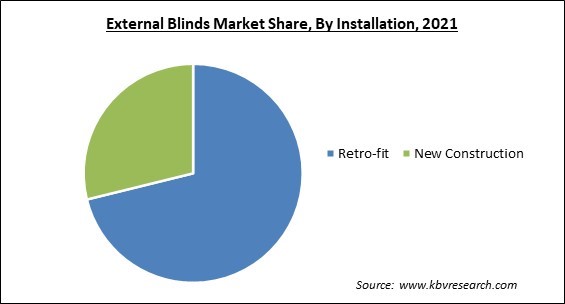The Global External Blinds Market size is expected to reach $16.3 billion by 2028, rising at a market growth of 6.9% CAGR during the forecast period.
An example of a window treatment is an exterior blind. In order to stop heat from coming into direct contact with the window, it is intended to be installed on the exterior of the building. In other words, exterior blinds may be made to block the heat and let the cold air in. They may shield damaging sun rays while allowing wind to pass through.

Controlling the amount of solar heat and light entering a building has a significant impact on its energy requirements. Even though specifiers have a variety of alternatives, external blinds are a really good choice. Correct solar shading techniques have a significant influence on the building's energy usage as well as the occupants' thermal and visual comfort.
In all kinds of buildings, from residential to commercial, the requirement to regulate overheating and maintain thermal comfort is becoming more and more crucial. As one of a number of passive cooling strategies, solar shading may be useful. It may lessen temperature changes that might happen on sunny days.
The solar transmittance value is utilized to calculate the quantity of solar radiation that enters a structure. You may also employ the shading coefficient, which results in solar transmittance, which is just a small portion of that for glass that is not shaded. If the system has a low solar transmittance or shade coefficient, it is especially effective in reducing solar gain. Of all the various shading solutions, external blinds have the least shading coefficient. Because they block incoming solar radiation before it enters the structure via the glass, it has been discovered that they are quite effective.
The COVID-19 pandemic had a negligible effect on the market for exterior blinds. Lockdowns and sluggish development in the construction business, especially in the real estate sector, are to blame for this. Metropolitan areas were the hub of cases at the pandemic's height, prompting authorities to implement severe lockdowns that slowed down house construction projects. Renovations of homes increased in popularity during the pandemic, however, market vendors reported a decline in sales of bespoke exterior blinds. The prohibition on home visits was another factor in this. A significant DIY sector has developed as a way to enable "affordable home décor improvements." Additionally, trade exhibitions were postponed or canceled.
The rise of the external blinds market is projected to be aided by the expanding real estate sector throughout the forecast period. One of the most important factors promoting market growth is the growing rate of commercial and residential commercial operations and their completion in both developed and emerging countries. As people's affordability and buying power rise, there is a significant rise in the demand for new homes. Over the projected period, market growth at a macro level is anticipated to be driven by the growing hospitality industry. The need for hotels, airbnbs, hostels, and other hospitality venues rises as tourism picks back up throughout the world, fueling the expansion of the external blinds industry.
Rapid urbanization and population growth are overrunning the earth. Cities in developing countries like India continue to see an increase in emigration to urban regions. In order to satisfy the expectations of the present generation, natural resources are under extreme strain. The population of rural areas is moving en masse to metropolitan areas in quest of better employment and educational possibilities. There is an urgent need to provide appropriate accommodations for contemporary living solutions. These folks like creating attractive external and interior designs for their houses. Therefore, it is anticipated that rising urbanization and social media platforms will boost the expansion of the external blinds industry.
External blinds are quite inexpensive. But there are alternatives available on the market. Less costly options include tie-up curtains, roller and shutter blinds, window film, grass shades, and others. While some of the goods are inexpensive, others are more durable. Roller shutters provide superior security and have a longer shelf life than exterior blinds and shades. However, by raising consumer awareness via campaigns and marketing, major manufacturers may be able to overcome this challenge and take advantage of new prospects in the external blinds industry.
Based on product, the external blinds market is divided into vertical blinds, panel blinds, corded blinds, venetian blinds, roller blinds, and others. The vertical blinds segment acquired a substantial revenue share in the external blinds market in 2021. The tilt and angle capabilities of a vertical blind are superior than those of others blinds. Cleaning vertical blinds is a breeze. The slats can be easily removed from the tracks to be washed and dried if they are made of fabric. Any other material can simply be lightly dusted or swiped with a moist cloth. With these benefits of vertical blinds over others, the market is accelerating in this segment.

Based on material type, the external blinds market is segmented into metal, wood, plastic, and others. In 2021, the wood segment acquired the prominent revenue share in the external blinds market. Its advantages, including toughness, increased comfort, and aesthetic appeal, are blamed for the rapid growth. One of the most often utilized raw materials for the production of furniture is wood. One of the most popular materials for use in home décor is wood.
Based on application, the external blinds market is divided into residential and commercial. In 2021, the commercial segment covered a substantial revenue share in the external blinds market. The possibility for the product has grown due to the rise in hotels and restaurants brought on by the global travel and tourist sector. The market for these items has also been boosted globally by the growth of malls, retail establishments, and workplaces. Also, the demand is rising as commercial buildings owners wish to have an appealing look of the buildings.
Based on the operating system, the external blinds market is divided into automated and manual. In 2021, the manual operating system segment had the most revenue share. Because the position and adjustment are hand-controlled, it is easy to reduce or increase the blind height without having to go through a laborious procedure. Due to the increased safety features of cordless or short-corded window coverings, consumers still prefer manual window coverings. The use of a smart window covering in both the residential and commercial sectors is further encouraged by the growing use of smart devices and the resurgence of smart home ideas.
Based on the installation, the external blinds market is divided into new construction and retrofit. The retrofit segment garnered the largest revenue share in the market in 2021. Home remodeling is becoming more popular than buying a new house. Customers are increasingly turning to house renovation because of the high expenditures related to property prices and mortgage rates. For example, according to RubyHome, homeowners in the US spent an average of USD 10,341 on home improvements in 2021, up by 25% from the year before.
| Report Attribute | Details |
|---|---|
| Market size value in 2021 | USD 10.3 Billion |
| Market size forecast in 2028 | USD 16.3 Billion |
| Base Year | 2021 |
| Historical Period | 2018 to 2020 |
| Forecast Period | 2022 to 2028 |
| Revenue Growth Rate | CAGR of 6.9% from 2022 to 2028 |
| Number of Pages | 268 |
| Number of Tables | 539 |
| Report coverage | Market Trends, Revenue Estimation and Forecast, Segmentation Analysis, Regional and Country Breakdown, Companies Strategic Developments, Company Profiling |
| Segments covered | Product, Operating System, Material, Installation, Application, Region |
| Country scope | US, Canada, Mexico, Germany, UK, France, Russia, Spain, Italy, China, Japan, India, South Korea, Singapore, Malaysia, Brazil, Argentina, UAE, Saudi Arabia, South Africa, Nigeria |
| Growth Drivers |
|
| Restraints |
|
Based on region, the external blinds market is categorized into North America, Europe, Asia Pacific, and LAMEA. The North American region held the largest revenue share in 2021 in the external blinds market. The most efficient and cost-effective window treatment options are window shades and blinds. In addition, effective energy savings are facilitated by shade installation. For instance, installing blinds set right up against neighboring walls and near the window provides a tight seal that reduces both heat absorption and loss. The US Department of Energy (DOE) claims that a simple arrangement of light-colored draperies paired with white plastic may cut solar heat gain by 33%.
Free Valuable Insights: Global External Blinds Market size to reach USD 16.3 Billion by 2028
The market research report covers the analysis of key stake holders of the market. Key companies profiled in the report include Hunter Douglas N.V., StellaGroup, SAS (PAI Partners SAS), Griesser AG, Country Blinds Pty Ltd., MHZ Hachtel GmbH & Co. KG, ŽALUZIE NEVA s.r.o., Schenker Storen AG, Verano B.V., and WAREMA Renkhoff SE.
By Operating System
By Material
By Installation
By Application
By Product
By Geography
The global External Blinds Market size is expected to reach $16.3 billion by 2028.
The rise in real estate sector are driving the market in coming years, however, Substitutions and copying restraints the growth of the market.
Hunter Douglas N.V., StellaGroup, SAS (PAI Partners SAS), Griesser AG, Country Blinds Pty Ltd., MHZ Hachtel GmbH & Co. KG, ŽALUZIE NEVA s.r.o., Schenker Storen AG, Verano B.V., and WAREMA Renkhoff SE.
The Metal segment acquired maximum revenue share in the Global External Blinds Market by Material in 2021 thereby, achieving a market value of $6.4 billion by 2028.
The Residential segment is leading the Global External Blinds Market by Application in 2021 thereby, achieving a market value of $10 billion by 2028.
The North America market dominated the Global External Blinds Market by Region in 2021, and would continue to be a dominant market till 2028; thereby, achieving a market value of $6.1 billion by 2028.
Our team of dedicated experts can provide you with attractive expansion opportunities for your business.

